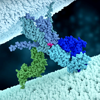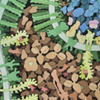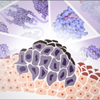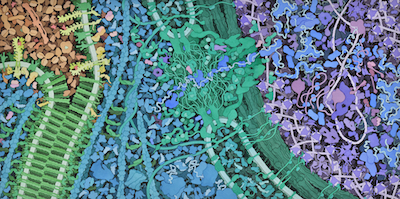 |
Actinomycin
Some antibiotics attack cells by intercalating between the bases in a DNA double helix
|
 |
Anaphase-Promoting Complex / Cyclosome
APC/C guards the checkpoints that regulate key steps in the cell cycle
|
 |
Apoptosomes
Apoptosomes make life or death decisions in cells
|
 |
ATM and ATR Kinases
Dividing cells use ATM and ATR kinases to respond to DNA damage.
|
 |
c-Abl Protein Kinase and Imatinib
Protein kinases are being targeted by new anti-cancer drugs
|
 |
Caspases
Caspases disassemble proteins during the process of programmed cell death
|
 |
Chimeric Antigen Receptors
T cells may be engineered with chimeric antigen receptors to attack cancer cells.
|
 |
Cisplatin and DNA
Cisplatin treats cancer by causing damage to the DNA of cancer cells.
|
 |
Cyclin and Cyclin-dependent Kinase
Cyclins and cyclin-dependent kinases control when cells divide, making them important targets for cancer therapy.
|
 |
Dihydrofolate Reductase
DHFR is a target for cancer chemotherapy and bacterial infection
|
 |
Epidermal Growth Factor
EGF is part of a family of proteins that controls aspects of cell growth and development
|
 |
Estrogen Receptor
Estrogen binds to receptors in the nucleus and affects key genes in development
|
 |
Glutathione Transferases
Glutathione transferase tags toxic molecules, making them easy to recognize and remove.
|
 |
Hepatitis C Virus Protease/Helicase
Structures of hepatitis C viral proteins have led to the discovery of direct-acting antivirals.
|
 |
HER2/neu and Trastuzumab
Trastuzumab monoclonal antibodies targeting HER2 receptors are at the forefront of breast cancer treatment
|
 |
Histone Deacetylases
Histone deacetylases regulate access to genetic information by modifying histones
|
 |
Hsp90
Heat shock proteins ensure that proteins remain folded and active under harsh conditions
|
 |
Human Papillomavirus and Vaccines
The capsid protein of papillomavirus is used in vaccines that prevent cervical cancer.
|
 |
Initiation Factor eIF4E
Initiation factors for protein synthesis interact through disordered chains.
|
 |
Major Histocompatibility Complex
MHC displays peptides on the surfaces of cells, allowing the immune system to sense the infection inside
|
 |
MDM2 and Cancer
MDM2 controls the action of p53 tumor suppressor, making it a target for cancer chemotherapy.
|
 |
Microtubules
The largest filaments of the cytoskeleton provide tracks for transport throughout the cell
|
 |
Nanodiscs and HDL
Nanodiscs conveniently package a small piece of membrane for experimental studies.
|
 |
Nicotine, Cancer, and Addiction
Nicotine causes addiction by interacting with receptors in the brain
|
 |
Non-Homologous End Joining Supercomplexes
Lethal double-strand breaks in the DNA genome are repaired by NHEJ
|
 |
p53 Tumor Suppressor
p53 tumor suppressor protects the body from DNA damage and cancer
|
 |
PD-1 (Programmed Cell Death Protein 1)
PD-1 and its ligands are a new target for cancer therapy
|
 |
Pyruvate Kinase M2
Pyruvate kinases are the paradoxical gatekeepers for cancer cell metabolism and growth.
|
 |
RAF Protein Kinases
A single mutation in a RAF protein kinase can help transform a normal cell into a cancer cell.
|
 |
Ras Protein
Mutation of the growth-controlling ras protein can lead to cancer
|
 |
RecA and Rad51
Broken DNA strands may be repaired by matching sequences in a duplicate copy of the DNA
|
 |
Ribonucleotide Reductase
Ribonucleotide reductase creates the building blocks of DNA
|
 |
Simian Virus 40
SV40 hijacks the cells it infects using only a handful of proteins
|
 |
Small Interfering RNA (siRNA)
Our cells continually look for pieces of double-stranded RNA, a possible sign of viral infection
|
 |
Spliceosomes
Cryoelectron microscropy is revealing how spliceosomes cut-and-paste messenger RNA molecules.
|
 |
Src Tyrosine Kinase
Growth signaling proteins play an important role in the development of cancer
|
 |
Telomerase
Telomerase maintains the ends of our chromosomes.
|
 |
Thymine Dimers
Ultraviolet light damages our DNA, but our cells have ways to correct the damage
|
 |
Topoisomerases
Topoisomerases untangle and reduce the tension of DNA strands in the cell
|
 |
Vascular Endothelial Growth Factor (VegF) and Angiogenesis
VegF promotes blood vessel formation (angiogenesis), affecting cancer proliferation, wound healing, and other bodily processes.
|




















































